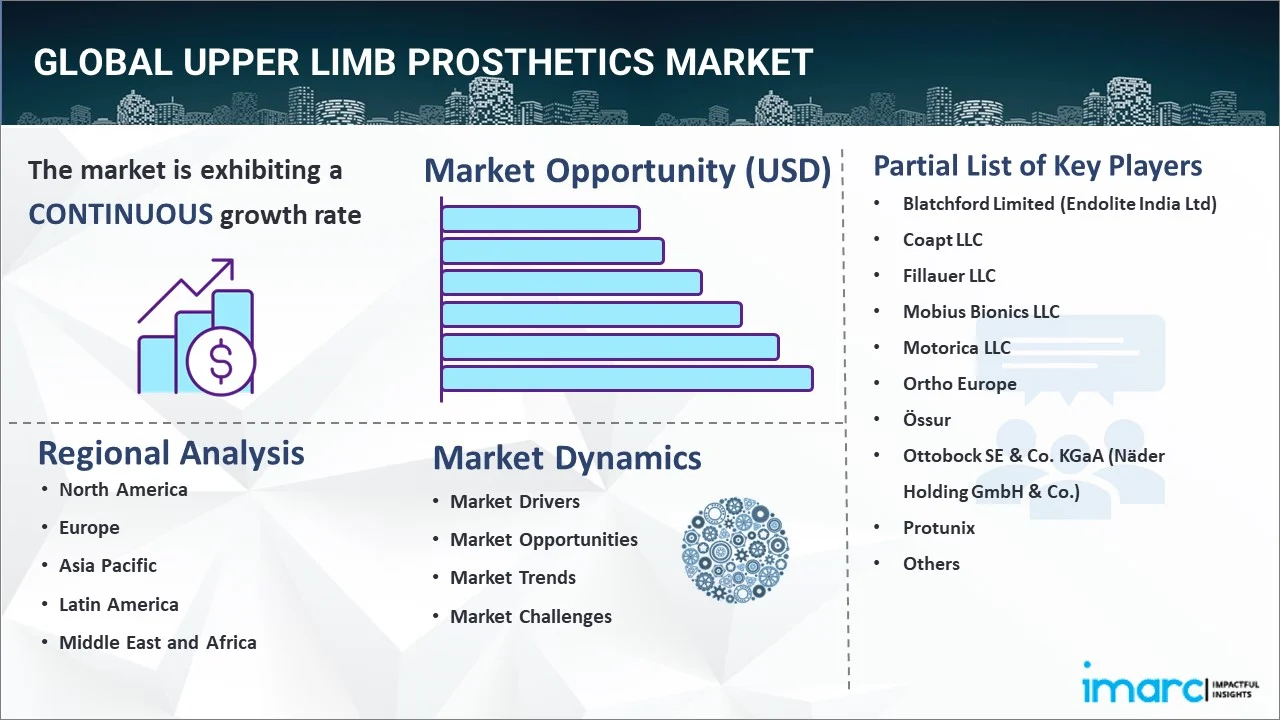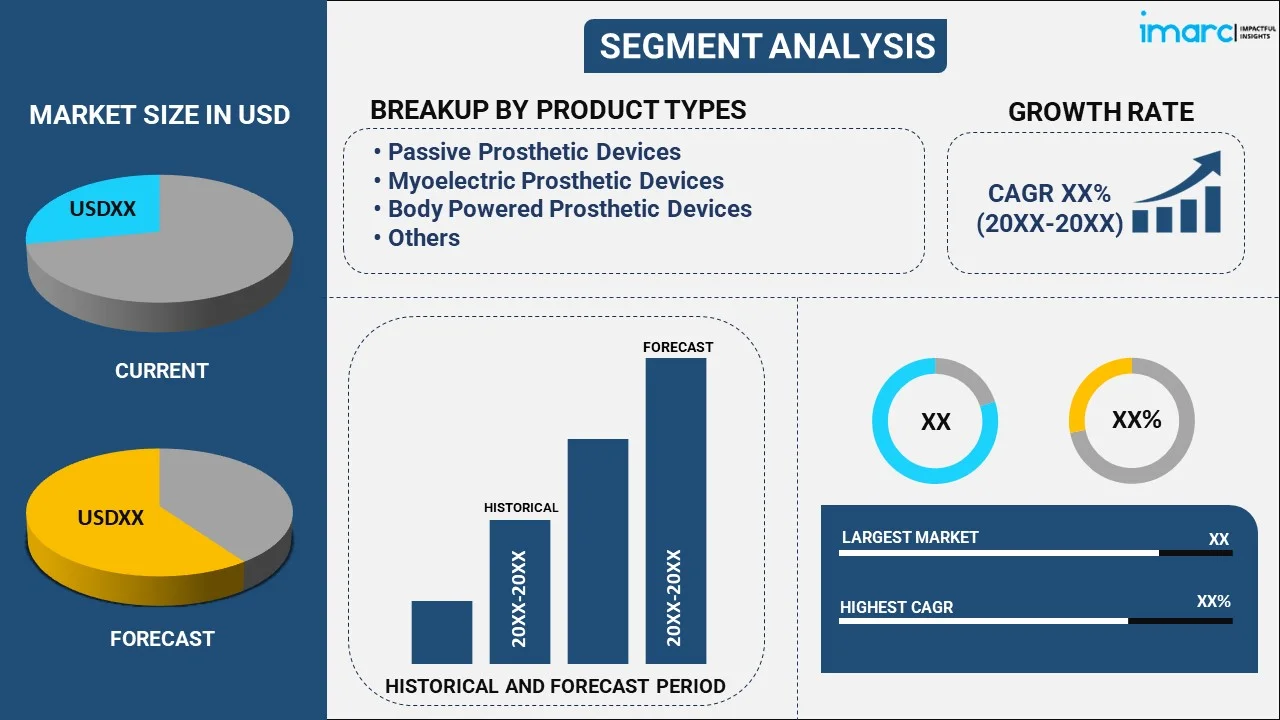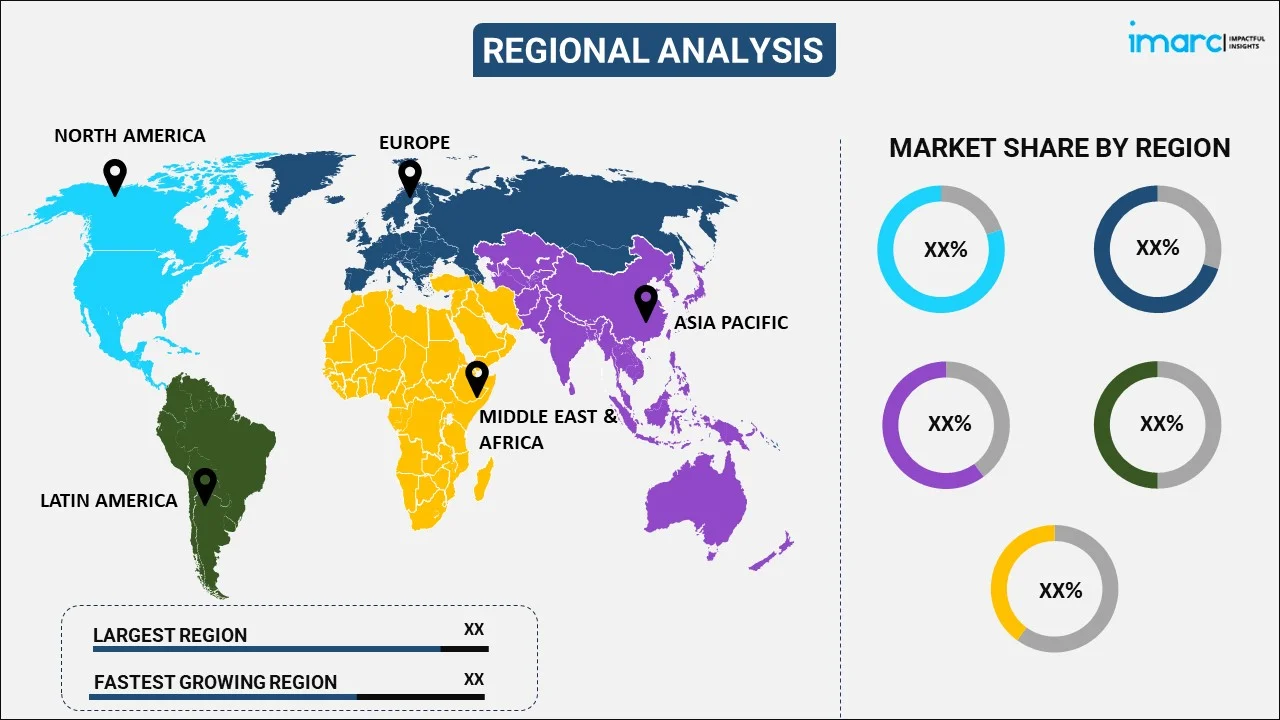
Upper Limb Prosthetics Market Report by Product Type (Passive Prosthetic Devices, Myoelectric Prosthetic Devices, Body Powered Prosthetic Devices, Hybrid Prosthetic Devices), Component (Prosthetic Wrist, Prosthetic Arm, Prosthetic Elbow, Prosthetic Shoulder, and Others), End Use (Hospitals, Prosthetic Clinics, and Others), and Region 2025-2033
Market Overview:
The global upper limb prosthetics market size reached USD 807.7 Million in 2024. Looking forward, IMARC Group expects the market to reach USD 1,223.7 Million by 2033, exhibiting a growth rate (CAGR) of 4.49% during 2025-2033. The rising prevalence of chronic and acute indications, significant growth in the healthcare sector and the growing aging population across the globe are factors influencing the market research report.
|
Report Attribute
|
Key Statistics
|
|---|---|
|
Base Year
|
2024 |
|
Forecast Years
|
2025-2033
|
|
Historical Years
|
2019-2024
|
| Market Size in 2024 | USD 807.7 Million |
| Market Forecast in 2033 | USD 1,223.7 Million |
| Market Growth Rate (2025-2033) | 4.49% |
Upper limb prosthetics are medical equipment that are designed to replace the upper limbs of the arms, hands, wrists, and fingers of individuals who have lost them due to injury, illness, or congenital disabilities. These prosthetic devices are intended to help restore function and independence to the user, allowing them to do activities they may have previously been unable to perform or complete. They range from simple to complex, depending on the level of functionality desired. For instance, simple prosthetics provide basic gripping and grasping capabilities, while more complex prosthetics are computerized and capable of performing complex tasks. Additionally, they consist of an artificial limb, socket, harness, and an interface and control system that allows the user to control and manipulate the prosthetic. Moreover, depending on the patient’s needs, they may include additional components, such as specialized tools and software. The most common types of upper limb prosthetics are myoelectric prosthetics, body-powered prosthetics, and passive prosthetics.

Upper Limb Prosthetics Market Trends:
Increasing amputation rates
Many industries, particularly construction and manufacturing, experience high rates of accidents resulting in limb amputations. The rising number of worldwide road traffic accidents is also leading to an increase in traumatic amputations. Diabetes causes issues, such as neuropathy and impaired circulation, which can lead to amputations. The growing frequency of these disorders, particularly in older populations, is increasing the number of people who need upper limb prosthetics. Surgical procedures to remove malignancies in the arms or shoulders might result in limb loss, adding to the demand for prosthetic options, which is propelling the upper limb prosthetics market growth. Another issue to consider is the prevalence of congenital limb abnormalities. Many people are born with upper limb impairments, which necessitates the usage of prosthetics from an early age.
Growing aging population
Diabetes, cardiovascular disease, and peripheral artery disease are more common in older persons, and these might cause problems that necessitate amputations. As these problems are growing more common with age, the demand for upper limb prosthetics is increasing. The elderly people are more vulnerable to falls and other mishaps, which can cause serious injuries and amputations. As more elderly people live alone or in circumstances where falls are common, the risk of traumatic amputations is rising, thereby catalyzing the demand for prosthetic devices. Advancements in the healthcare sector are resulting in longer life spans, which means that more people are entering old age with the possibility of disability, including limb loss. This demographic trend is increasing the number of people who may need prosthetics.
Technological advancements
Myoelectric prostheses employ electrical signals from the user's muscles to control the prosthetic device. This enables more natural and intuitive movements, which enhances the entire user experience. Sensor technology advancements are enabling prosthetics to execute intricate activities previously difficult for traditional prosthetics, such as grabbing and moving items. Bionic arms may move like a natural arm, providing a wide range of motion and utility. This includes elements like multi-articulating joints, which enable more realistic motion patterns. New bionic prosthetics have sensory feedback devices that allow users to sense pressure and sensations in their prosthetic limbs, increasing usefulness. 3D printing technology enables the rapid fabrication of custom-fit prosthetics based on the individual's wants and anatomy. When compared to standard manufacturing methods, this can result in considerable cost and lead time savings. The capacity to build sophisticated and lightweight designs with 3D printing can improve the appearance and functionality of prosthetic devices.
Key Market Segmentation:
IMARC Group provides an analysis of the key trends in each segment of the global upper limb prosthetics market report, along with forecasts at the global, regional, and country levels for 2025-2033. Our report has categorized the market based on product type, component, and end use.
Product Type Insights:

- Passive Prosthetic Devices
- Myoelectric Prosthetic Devices
- Body Powered Prosthetic Devices
- Hybrid Prosthetic Devices
The report has provided a detailed breakup and analysis of the upper limb prosthetics market based on the product type. This includes passive prosthetic devices, myoelectric prosthetic devices, body powered prosthetic devices, and hybrid prosthetic devices. According to the report, passive prosthetic devices represented the largest segment.
Component Insights:
- Prosthetic Wrist
- Prosthetic Arm
- Prosthetic Elbow
- Prosthetic Shoulder
- Others
A detailed breakup and analysis of the upper limb prosthetics market based on the component has also been provided in the report. This includes prosthetic wrist, prosthetic arm, prosthetic elbow, prosthetic shoulder, and others. According to the report, prosthetic arm accounted for the largest upper limb prosthetics market share.
End Use Insights:
- Hospitals
- Prosthetic Clinics
- Others
The report has provided a detailed breakup and analysis of the upper limb prosthetics market based on the end use type. This includes hospitals, prosthetic clinics, and others. According to the report, prosthetic clinics represented the largest segment.
Regional Insights:

- North America
- United States
- Canada
- Europe
- Germany
- France
- United Kingdom
- Italy
- Spain
- Others
- Asia Pacific
- China
- Japan
- India
- South Korea
- Australia
- Indonesia
- Others
- Latin America
- Brazil
- Mexico
- Others
- Middle East and Africa
The report has also provided a comprehensive analysis of all the major regional markets, which include North America (the United States and Canada); Europe (Germany, France, the United Kingdom, Italy, Spain, and others); Asia Pacific (China, Japan, India, South Korea, Australia, Indonesia, and others); Latin America (Brazil, Mexico, and others); and the Middle East and Africa. According to the report, North America was the largest market for upper limb prosthetics. Some of the factors driving the North America upper limb prosthetics market included its aging population, technological advancements, high healthcare expenditure, etc.
Competitive Landscape:
The report has also provided a comprehensive analysis of the competitive landscape in the global upper limb prosthetics market. Competitive analysis such as market structure, market share by key players, player positioning, top winning strategies, competitive dashboard, and company evaluation quadrant has been covered in the report. Also, detailed profiles of all major companies have been provided. Some of the companies covered include:
- Blatchford Limited (Endolite India Ltd)
- Coapt LLC
- Fillauer LLC
- Mobius Bionics LLC
- Motorica LLC
- Ortho Europe
- Össur
- Ottobock SE & Co. KGaA (Näder Holding GmbH & Co.)
- Protunix
- Steeper Group
Kindly note that this only represents a partial list of companies, and the complete list has been provided in the report.
Upper Limb Prosthetics Market News:
- February 2024: Koalaa, a startup that develop a range of soft prosthetic limbs that are light, comfortable, and suitable even for very young children, closed a £925,000 investment to drive its international expansion.
- September 2023: Össur announced that its upper limb research and development (R&D) hub, based in Livingston, Scotland, received a funding grant from Scottish Enterprise to support the development of new upper limb prosthetic solutions.
Upper Limb Prosthetics Market Report Scope:
| Report Features | Details |
|---|---|
| Base Year of the Analysis | 2024 |
| Historical Period | 2019-2024 |
| Forecast Period | 2025-2033 |
| Units | Million USD |
| Scope of the Report | Exploration of Historical and Forecast Trends, Industry Catalysts and Challenges, Segment-Wise Historical and Predictive Market Assessment:
|
| Product Types Covered | Passive Prosthetic Devices, Myoelectric Prosthetic Devices, Body Powered Prosthetic Devices, Hybrid Prosthetic Devices |
| Components Covered | Prosthetic Wrist, Prosthetic Arm, Prosthetic Elbow, Prosthetic Shoulder, Others |
| End Uses Covered | Hospitals, Prosthetic Clinics, Others |
| Regions Covered | Asia Pacific, Europe, North America, Latin America, Middle East and Africa |
| Countries Covered | United States, Canada, Germany, France, United Kingdom, Italy, Spain, China, Japan, India, South Korea, Australia, Indonesia, Brazil, Mexico |
| Companies Covered | Blatchford Limited (Endolite India Ltd), Coapt LLC, Fillauer LLC, Mobius Bionics LLC, Motorica LLC, Ortho Europe, Össur, Ottobock SE & Co. KGaA (Näder Holding GmbH & Co.), Protunix, Steeper Group, etc. |
| Customization Scope | 10% Free Customization |
| Post-Sale Analyst Support | 10-12 Weeks |
| Delivery Format | PDF and Excel through Email (We can also provide the editable version of the report in PPT/Word format on special request) |
Key Questions Answered in This Report:
- How has the global upper limb prosthetics market performed so far, and how will it perform in the coming years?
- What are the drivers, restraints, and opportunities in the global upper limb prosthetics market?
- What is the impact of each driver, restraint, and opportunity on the global upper limb prosthetics market?
- What are the key regional markets?
- Which countries represent the most attractive global upper limb prosthetics market?
- What is the breakup of the market based on the product type?
- Which is the most attractive product type in the upper limb prosthetics market?
- What is the breakup of the market based on the component?
- Which is the most attractive component in the upper limb prosthetics market?
- What is the breakup of the market based on end use?
- Which is the most attractive end use in the upper limb prosthetics market?
- What is the competitive structure of the global upper limb prosthetics market?
- Who are the key players/companies in the global upper limb prosthetics market?
Key Benefits for Stakeholders:
- IMARC’s report offers a comprehensive quantitative analysis of various market segments, historical and current market trends, market forecasts, and dynamics of the upper limb prosthetics market from 2019-2033.
- The research study provides the latest information on the market drivers, challenges, and opportunities in the global upper limb prosthetics market.
- The study maps the leading, as well as the fastest-growing, regional markets. It further enables stakeholders to identify the key country-level markets within each region.
- Porter's five forces analysis assist stakeholders in assessing the impact of new entrants, competitive rivalry, supplier power, buyer power, and the threat of substitution. It helps stakeholders to analyze the level of competition within the upper limb prosthetics industry and its attractiveness.
- Competitive landscape allows stakeholders to understand their competitive environment and provides an insight into the current positions of key players in the market.
Need more help?
- Speak to our experienced analysts for insights on the current market scenarios.
- Include additional segments and countries to customize the report as per your requirement.
- Gain an unparalleled competitive advantage in your domain by understanding how to utilize the report and positively impacting your operations and revenue.
- For further assistance, please connect with our analysts.
 Inquire Before Buying
Inquire Before Buying
 Speak to an Analyst
Speak to an Analyst
 Request Brochure
Request Brochure
 Request Customization
Request Customization




.webp)




.webp)












